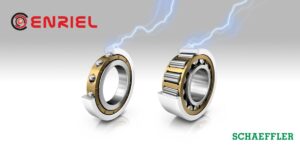What is a geared motor and why is it essential in your industry?
Geared motors: The silent force behind industry. Imagine a world without precise, controlled motion. From the production lines of a factory to the robotic arms of an assembly plant, motion is essential. And behind that motion, often silent and efficient, are geared motors.
What is a geared motor?
A geared motor is an electromechanical device that combines a motor, as a generator of rotary motion operating at high speeds, and a gearbox consisting of a system of gears, which transmits the motion from the motor to the outside. The purpose of both is to modify the speed (rpm) and the output force or torque (Nm) with the power and precision necessary for the correct operation of any machine in various industrial applications. The objective is that the input speed is regulated and generates another output speed, this is the one that allows the machinery to move under a controlled force to avoid damaging the equipment.
How does a geared motor work?
The operation of a geared motor is simple. The motor drives a high-speed gear (called a pinion) which is in contact with a low-speed gear (called a ring gear). As the ring gear is larger than the pinion, more force is required to move it, resulting in a decrease in speed and an increase in torque (Nm). This operation is repeated in the different stages, multiplying the gear ratios, generating more torque and consequently decreasing the speed.

Main uses in industry:
- Industrial automation: production lines, industrial robots, packaging systems.
- Transport: Conveyor belts, elevators, automatic doors.
- Energy: and Mining: Wind generators, solar panels.
- Food: Packaging machinery, mixers.
- Chemical, construction and waste management industries among many others.
Key features:
- Versatility: Wide range of sizes, powers and reduction ratios.
- Efficiency: Power transmission with minimal losses.
- Durability: Designed to withstand demanding industrial conditions.
- Accuracy: Precise motion control.
Advantages for Industry:
Integrating geared motors into industrial systems offers a number of advantages:
- Energy efficiency: By adjusting speed and torque as required, greater energy efficiency can be achieved, reducing electricity consumption.
- Reduced size and weight: Geared motors allow the design of more compact and lighter machines, optimising space and facilitating installation and maintenance.
- Versatility: The wide range of geared motors available makes it possible to apply them in practically any industrial field.

The classification of geared motors is fundamental in the selection of the right component for each industrial application. It is very important to know the different types and their applications, which will allow us to make the correct selection of a geared motor, which not only optimises the performance and efficiency of a machine, but also contributes significantly to the sustainability and economy of industrial processes. In the next post we will discuss their classification.
When selecting a gearmotor, the environment in which it will operate must be taken into account. The environment can significantly affect its selection. Important factors such as temperature, humidity, or the presence of corrosive agents must be taken into account in order to choose a geared motor with the appropriate protections for our needs.
Do you want to find out how a geared motor can revolutionise your production process?
Contact us! We will help you find the perfect solution for your specific needs.
Phone: +34- 986.21 35 35 – EXT. 5
Mail: ventas@enriel.com

High-performance industrial lubricant, key to operational efficiency.




